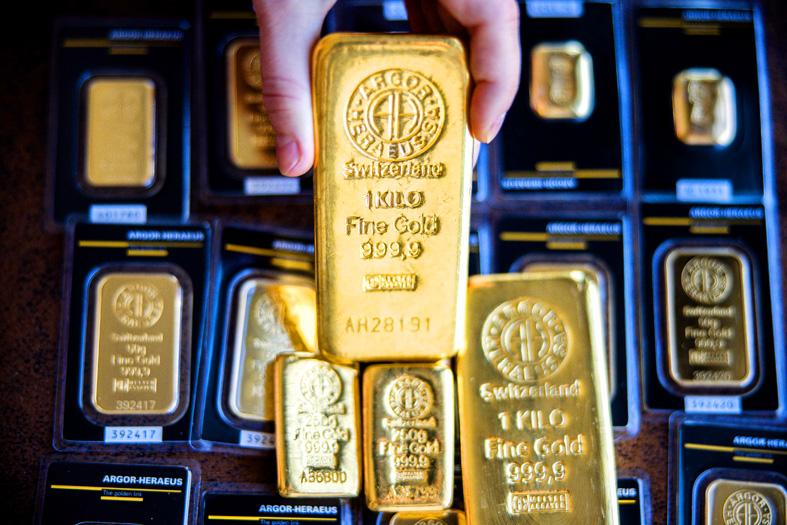Gold posted a second straight gain as investors weighed the impacts of new US sanctions on Russia and the outlook for economic growth.
The US is working with NATO allies to prepare for the possibility of Russia deploying biological, chemical or nuclear weapons as part of the Ukraine war, US National Security Adviser Jake Sullivan said on Thursday.
Meanwhile, a government report showed orders placed with US factories for business equipment unexpectedly declined last month for the first time in a year.

Photo: Bloomberg
The war in Ukraine and ensuing sanctions have pushed up commodity prices and fueled inflation, resulting in faster monetary tightening from some central banks while also threatening growth.
The US Federal Reserve’s more hawkish tone and higher US bond yields are weighing on non-interest bearing bullion, but gold is also benefiting from its appeal as a store of value.
Spot gold on Friday rose to US$1,958.32 an ounce in New York, up 1.3 percent for the week.
Silver and platinum advanced, and palladium was little changed.
Elevated inflation prints “and geopolitical uncertainty should drive gold modestly higher,” analysts at Morgan Stanley wrote in a note, forecasting US$2,000 an ounce in the second quarter of this year.
“We expect gold to come under pressure later in the year as central banks raise rates to combat inflation,” they said.
NICKEL
Nickel prices swung sharply in barely there volumes at the end of a tumultuous week on the London Metal Exchange (LME), in which futures spent most trading sessions locked either limit-up or limit-down.
Since reopening on March 16, Friday was only the second day that the nickel market remained within the LME’s new daily price limits as it seeks to reset after a massive short squeeze sent prices spiking.
However, the extreme lack of liquidity in the market has left it exposed to erratic moves — prices rallied more than 9 percent and then fell as much as 7.4 percent in just the first 45 minutes of trading.
The ongoing turmoil in the market is raising questions about the role and future of the LME as the place where benchmark prices are set for some of the world’s most important industrial metals.
The exchange has come under furious criticism for its handling of this month’s nickel crisis. Traders remain wary of the threat of another squeeze — there are still large short positions in the market that would have come under growing pressure during a two-day limit-up spike earlier in the week.
The LME suspended trading for a week and canceled billions of dollars of transactions earlier this month as it sought to rein in the runaway short-squeeze centered on China’s Tsingshan Holding Group Co (青山控股).
Trading has been effectively frozen for much of the time since the market reopened last week, with prices falling by a daily limit for several days. While the market saw some real trading on Tuesday, the price surged limit-up on Wednesday and Thursday.
Prices are still up 45 percent this month, set for the biggest gain since 1988, and the LME on Friday said it would nearly double the size of its default fund in response to the recent volatility.
Nickel was trading 5.5 percent lower at US$35,175 a ton on Friday, having earlier slumped by US$6,200 from its intraday high, in the second-biggest intraday swing on record, excluding trading on March 8.

Shares in Taiwan closed at a new high yesterday, the first trading day of the new year, as contract chipmaker Taiwan Semiconductor Manufacturing Co (TSMC, 台積電) continued to break records amid an artificial intelligence (AI) boom, dealers said. The TAIEX closed up 386.21 points, or 1.33 percent, at 29,349.81, with turnover totaling NT$648.844 billion (US$20.65 billion). “Judging from a stronger Taiwan dollar against the US dollar, I think foreign institutional investors returned from the holidays and brought funds into the local market,” Concord Securities Co (康和證券) analyst Kerry Huang (黃志祺) said. “Foreign investors just rebuilt their positions with TSMC as their top target,

REVENUE PERFORMANCE: Cloud and network products, and electronic components saw strong increases, while smart consumer electronics and computing products fell Hon Hai Precision Industry Co (鴻海精密) yesterday posted 26.51 percent quarterly growth in revenue for last quarter to NT$2.6 trillion (US$82.44 billion), the strongest on record for the period and above expectations, but the company forecast a slight revenue dip this quarter due to seasonal factors. On an annual basis, revenue last quarter grew 22.07 percent, the company said. Analysts on average estimated about NT$2.4 trillion increase. Hon Hai, which assembles servers for Nvidia Corp and iPhones for Apple Inc, is expanding its capacity in the US, adding artificial intelligence (AI) server production in Wisconsin and Texas, where it operates established campuses. This

US President Donald Trump on Friday blocked US photonics firm HieFo Corp’s US$3 million acquisition of assets in New Jersey-based aerospace and defense specialist Emcore Corp, citing national security and China-related concerns. In an order released by the White House, Trump said HieFo was “controlled by a citizen of the People’s Republic of China” and that its 2024 acquisition of Emcore’s businesses led the US president to believe that it might “take action that threatens to impair the national security of the United States.” The order did not name the person or detail Trump’s concerns. “The Transaction is hereby prohibited,”

Garment maker Makalot Industrial Co (聚陽) yesterday reported lower-than-expected fourth-quarter revenue of NT$7.93 billion (US$251.44 million), down 9.48 percent from NT$8.76 billion a year earlier. On a quarterly basis, revenue fell 10.83 percent from NT$8.89 billion, company data showed. The figure was also lower than market expectations of NT$8.05 billion, according to data compiled by Yuanta Securities Investment and Consulting Co (元大投顧), which had projected NT$8.22 billion. Makalot’s revenue this quarter would likely increase by a mid-teens percentage as the industry is entering its high season, Yuanta said. Overall, Makalot’s revenue last year totaled NT$34.43 billion, down 3.08 percent from its record NT$35.52